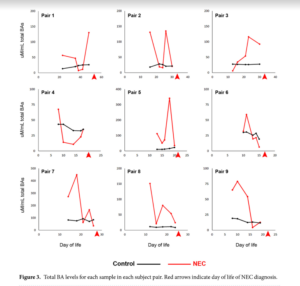Tiny Fighters: The Details and Technicalities
Hi everyone! Thanks for popping back in!
Today, I will share the findings of my research that I have not only collected from various research documents but also analyzed. My focus is to provide a comprehensive overview of the biological mechanisms that contribute to Necrotizing Enterocolitis (NEC).
One of the underlying mechanisms that play a crucial role in the development of NEC is the negative feedback mechanism that regulates bile acid metabolism. Bile acids are essential agents that facilitate the absorption of dietary fats. The more we consume foods rich in fat, the more bile acids our body produces to absorb those fats. Bile acids play a crucial role in bile acid homeostasis, which protects the liver and other tissues and cells from cholesterol toxicity and bile acids.
The feedback loop that regulates bile acid metabolism starts in the liver, where bile acids are synthesized and excreted in bile, which is then transported to the gallbladder. When needed, bile is released into the small intestinal tract, where bile acids are reabsorbed in the ileum of the small intestine by the Apical Sodium-dependent Bile Acid Transporter (ASBT) in the brush border membrane. Bile acids are used to induce the expression of the Intestinal Bile Acid Binding Protein (IBABP) in enterocytes. Some bile acids remain in the small intestine to absorb lipid-soluble compounds, fats, and steroids, while others return to the liver, where they regulate the amount of bile acids that need to be exported in response to the amount of bile acids that return.
An accumulation of bile acids in the intestine can result in damage to the intestinal epithelium. Additionally, bile acid transporters, such as ASBT, IBABP, Ostα, and Ostβ, are immature at birth, making them vulnerable to alterations that can contribute to the rise in bile acids in the intestine. The majority of bile acid reclamation occurs in the ileum and colon, which are the primary sites of NEC injury. Increased bile acid levels are positively correlated with NEC severity, and they can cause intestinal inflammation, oxidative stress, and cell death.
The graphs below depict the disparity in the coefficient of variation for bile acid levels between the control groups and infants with NEC. These graphs measure the magnitude of the fluctuations found in bile acids. These fluctuations are useful in predicting NEC because those with immense or drastic fluctuations, like Pair 7, are said to have unstable bile acid levels, which correlate or lead to the conclusion of the possibility of symptoms of NEC. Stable levels of bile acids indicate that the infant most likely does not have NEC.
It is very difficult to find infants that have biological mechanisms that mirror each other. Numerous environmental factors affect these mechanisms, making it harder to isolate variables compared to rats and mice. This is partly because of ethical guidelines and partly because these animals have biological mechanisms that are easier to work around. The above graphs show a sample size that led to considerable and accurate results, but it was tough to obtain. To compare the control and NEC infants side-by-side, they had to mirror each other in their biological systems.
By conducting experiments and looking at infant samples in the lab, I hope to learn more about these complex interactions and identify potential targets for NEC. However, I believe that a better understanding of bile acid biology will help us develop more effective treatments for this condition. Thank you for reading!

